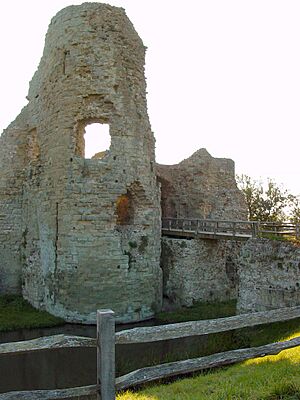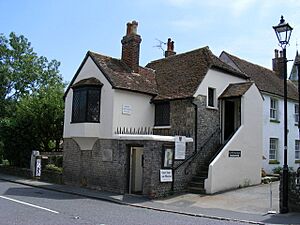Pevensey facts for kids
Quick facts for kids Pevensey |
|
|---|---|
| Village | |
 Pevensey High Street |
|
The council's logo |
|
| Area | 6.80 sq mi (17.6 km2) |
| Population | 3,153 (2011) |
| • Density | 464/sq mi (179/km2) |
| OS grid reference | TQ635052 |
| • London | 50 mi (80 km) NNW |
| District |
|
| Shire county | |
| Region | |
| Country | England |
| Sovereign state | United Kingdom |
| Post town | PEVENSEY |
| Postcode district | BN24 |
| Dialling code | 01323 |
| Police | Sussex |
| Fire | East Sussex |
| Ambulance | South East Coast |
| EU Parliament | South East England |
| UK Parliament |
|
| Website | Parish Council |
Pevensey is a village and civil parish in East Sussex, England. It is about 5 miles (8 km) north-east of Eastbourne. The village is located about 1 mile (1.6 km) inland from the coast. The nearby settlement of Pevensey Bay is also part of the parish. Pevensey is famous because William the Conqueror landed here in 1066 when he invaded England.
Contents
What is Pevensey Like?
Pevensey sits on a small hill made of sand and clay, about 10 meters (33 feet) above sea level. Long ago, this hill was a peninsula sticking out into a large bay with marshes. A small river called Pevensey Haven runs along the north side. This river used to flow into the bay, but now it's mostly filled with mud.
Over time, shingle (small stones) built up along the coast, separating the bay from the sea. What's left today are the marshes, known as the Pevensey Levels.
Pevensey Levels: A Special Place for Nature
The Pevensey Levels are a huge area of marshes, covering about 47 square miles (120 km²). This area is a Site of Special Scientific Interest, meaning it's very important for nature. It's also a large nature reserve, looked after by Natural England and the Sussex Wildlife Trust.
You can find many rare plants and insects here, including the Great raft spider. Because the area is so delicate, people are usually not allowed to walk freely through it.
Pevensey is also the starting point of the 1066 Country Walk. This is a long walking path that takes you past many historical sites in the area.
Pevensey Bay: A Small Seaside Town
Pevensey Bay is located right on the shingle beach. Even though it's small, it has many things you'd find in a bigger seaside resort. The shingle beach here is very important because it protects a large area of low-lying land from flooding and storm damage from the sea.
You can also see two Martello towers here. These towers were built in 1806 to defend the coast against a possible attack by Napoleon. Before the area was developed, it was known as Wallsend, with only the 16th-century Castle Hotel standing on the beach.
Where Does the Name Pevensey Come From?
The name Pevensey has been around for a very long time, first appearing in old documents from the years 788 and 790. It has been spelled in different ways, like Pefensea and Pæfensea.
The name means "River of [a man named] Pefen." It comes from an old Anglo-Saxon name, Pefen, combined with eã, which means "river." This probably refers to the Pevensey Haven river, which is now mostly filled with mud. Locally, people sometimes pronounce it like "Pimzi" or "Pemzi."
A Look at Pevensey's Past
The Roman Fort of Anderitum
Around the 4th century AD, the south and east parts of Roman Britain were often attacked by tribes like the Jutes and Saxons. To stop these attacks, the Romans built a series of eleven forts along the coast, known as the Saxon Shore Forts.
The fort at Pevensey, built between AD 300 and 340, was called Anderitum. The oldest stone parts you can still see today are from the Roman times. The sea used to surround the fort on three sides, covering what are now the Pevensey Marshes.
When the Roman army left Britain, the area was more open to attacks. Around 491 AD, Saxons, possibly led by Ælle of Sussex, attacked Anderitum. After a long fight, the fort was taken. The old Roman fort was burned and left in ruins. For a while, the Saxons called the ruined castle Andredceaster. The large forest area nearby was named Andredsweald, meaning the Forest of Anderida.
The fort likely stayed in ruins until 1042. That's when Harold Godwinson, who later became Harold II of England, made it a stronghold. He made the defenses stronger by digging ditches inside the fort walls. The English army stayed there in the summer of 1066, but then left to fight the invading Norwegians further north.
When William the Conqueror invaded Sussex in September 1066, there were no defenders at Pevensey. The bay was a safe place for his invading fleet to land.
Pevensey Castle
Soon after the Norman Conquest in 1066, the Normans took over the Roman fort at Pevensey. Much of the Roman stonework you see today is thanks to Robert, Count of Mortain, who was William the Conqueror's half-brother. He was given Pevensey Castle shortly after the invasion. Robert de Mortain used the old Roman walls as the base for his new castle. He made small repairs to the outer walls and built a new inner castle area at the eastern end.
The castle was attacked many times between the 11th and 13th centuries. Even Queen Elizabeth I ordered it to be torn down once, but her order was ignored. Later, during the time of the Commonwealth of England, another attempt to demolish it also failed.
As late as 1942, during World War II, small changes were made to the castle. It was used to spot German aircraft as part of Britain's defense. Today, English Heritage looks after the castle.
Other Important Events
In the 16th century, Pevensey became a "non-corporate limb" of Hastings. This meant it was part of the Cinque Ports, a group of important coastal towns. However, like many other Ports, Pevensey's importance faded as the sea moved further away from the town.
During the 18th and 19th centuries, Pevensey Bay was a popular spot for smuggling. It was an easy place to land illegal goods. In 1833, there was a violent fight between smugglers and customs officers at Pevensey Bay.
Many of the more than 100 Martello towers were built along the beaches of Pevensey Bay in the early 1800s. These were built to defend against a possible attack from Napoleon.
How Pevensey is Governed
In 1207, King John gave Pevensey a special royal charter, and the town was run by the Pevensey Corporation. But as the town became less important by the 19th century, the Corporation was closed down in 1886. Pevensey then lost its status as a borough.
Today, Pevensey is a village with a parish council made up of twelve elected members. Three councillors are also elected to the Wealden District Council to represent Pevensey. The Member of Parliament for the area is Huw Merriman, who represents the Bexhill and Battle Constituency.
Places of Worship
Pevensey parish has several churches:
- St. Nicolas Church, Pevensey, the main Anglican church.
- St Wilfrid's church in Pevensey Bay.
- The Wesleyan Methodist church.
- The Pevensey Bay Free Church.
- Holy Rood Catholic church in Pevensey Bay.
Historic Buildings
Pevensey has 23 buildings that are considered historically important by English Heritage. These include the Grade I listed St Nicolas church and the Grade II* listed Old Mint House. In 2022, the Old Mint House was added to English Heritage's list of buildings at risk of falling apart.
Getting Around Pevensey
The A259 road goes through Pevensey. There are also two railway stations that serve the area: Pevensey and Westham and Pevensey Bay.
Pevensey in Books and Art
- The famous artist J. M. W. Turner painted Pevensey Castle.
- Pevensey appears several times in Rudyard Kipling's book Puck of Pook's Hill (1907). Kipling's characters call it "England's Gate" because of its history.
- The story of the Roman fort Anderitum falling is in the 1875 novel Anderida: or the Briton and the Saxon, A. D. CCCCXLI by Thomas Burnside Crowther.
- Pevensey is featured in The Saxon Shore (1983), a book of photographs by Fay Godwin.
- Parts of George Gissing's 1887 novel Thyrza are set in Pevensey.
- Robert Sheldon wrote a music piece called Pevensey Castle in 1993.
- Pevensey Bay is a setting in the 1946 crime novel Uneasy Terms by Peter Cheyney.
- Pevensey Bay was the landing place for characters in Salman Rushdie's The Satanic Verses.
- Pevensey was mentioned in the memoirs of comedian Spike Milligan. During World War II, he was stationed nearby and used a Martello tower in Pevensey as an observation post.
Sports in Pevensey
The Pevensey Bay Sailing Club has many different types of boats. The club was important in developing certain racing dinghies in the 1970s. Phil Morrison, a British yacht designer whose son Stevie Morrison became an Olympic sailor, was a member here. The village also has its own cricket team.
See also
 In Spanish: Pevensey para niños
In Spanish: Pevensey para niños




